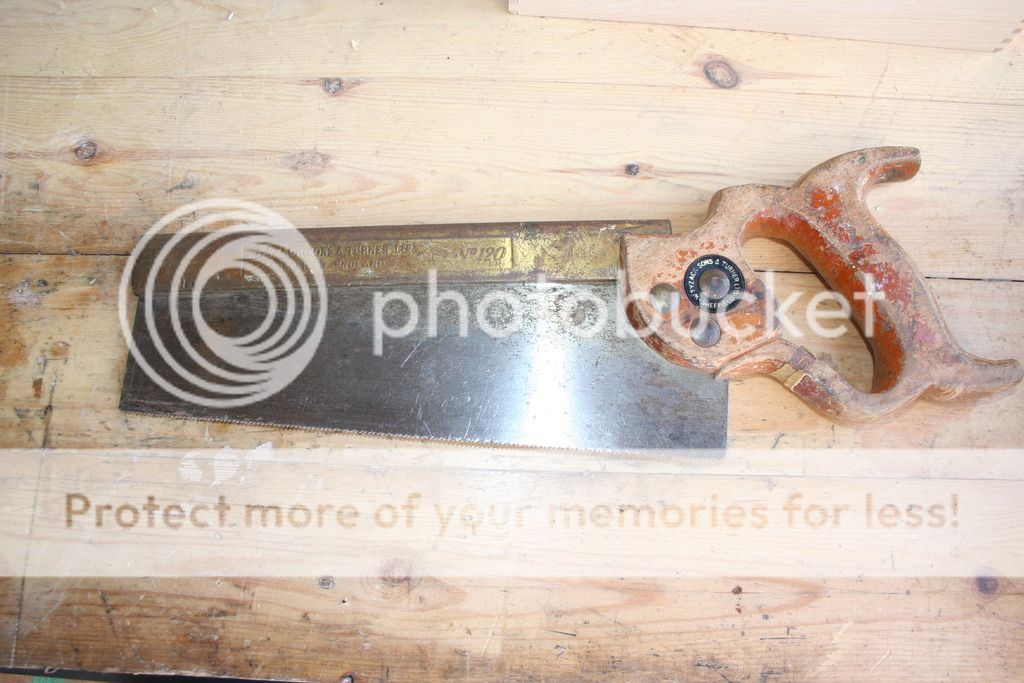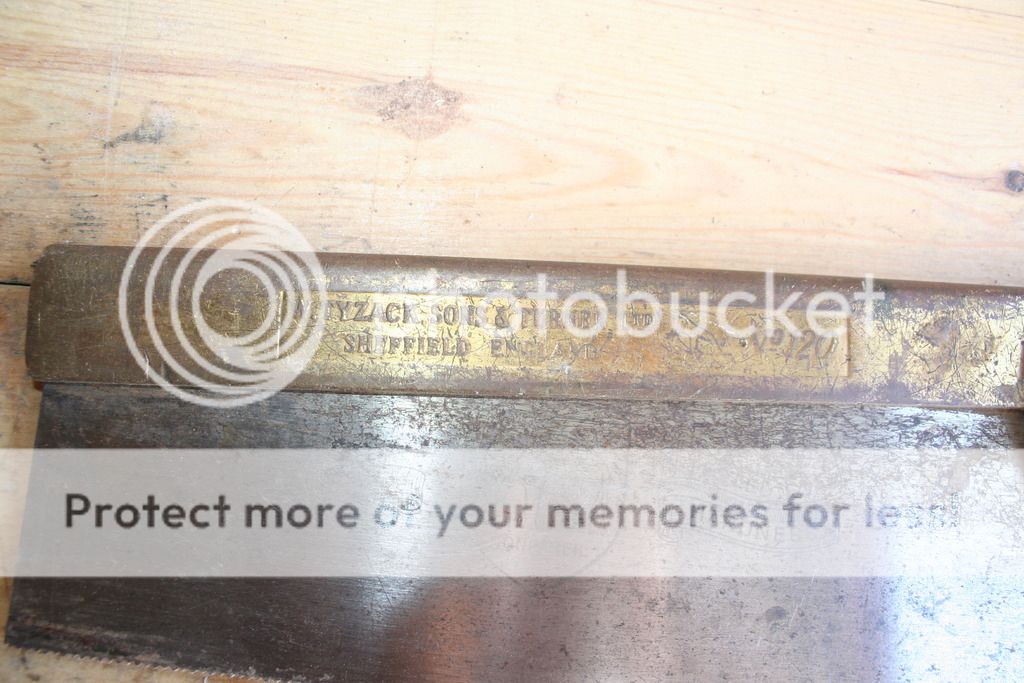You are using an out of date browser. It may not display this or other websites correctly.
You should upgrade or use an alternative browser.
You should upgrade or use an alternative browser.
Last question (I think)
- Thread starter sunnybob
- Start date

Help Support UKworkshop.co.uk:
This site may earn a commission from merchant affiliate
links, including eBay, Amazon, and others.
NickN
Established Member
As it's a 'Ltd' and not Nonpareil that normally dates such saws to probably later than 1906, and with this example, the more modern engraving, plus the disc around the medallion, plus the rather crude lamb's tongue means it is almost certainly a 1950s to 1960s saw. Nice piece though and worth hanging onto if you use hand saws at all.
Tyzack & Sons actually operated from 1867 to 1990.
Your saw blade I assume is 14" / 35cm long, with around 10-11 teeth per inch? If so it could go by two names, either the commonly and normally used phrase 'tenon saw' or to be more specific, a 'sash saw' was historically used for a saw of around 14-16" long (longer were tenon saws, shorter were carcass saws, followed by dovetail saws being the shortest at around 8-10")
Tyzack & Sons actually operated from 1867 to 1990.
Your saw blade I assume is 14" / 35cm long, with around 10-11 teeth per inch? If so it could go by two names, either the commonly and normally used phrase 'tenon saw' or to be more specific, a 'sash saw' was historically used for a saw of around 14-16" long (longer were tenon saws, shorter were carcass saws, followed by dovetail saws being the shortest at around 8-10")
Very helpful, thanks.
Non parell is stamped onto the metal along with a crest and something that looks like "monesses"
I have tried a test cut and although it cut smoothly, seems blunt. I dont have a fine toothed saw so this one will actually be kept. I have no idea how to sharpen a saw, I assume theres a thread here somewhere?
Can the blade be taken out of the brass spine? or is that a step too far for someone as inept at restoration as me.
Non parell is stamped onto the metal along with a crest and something that looks like "monesses"
I have tried a test cut and although it cut smoothly, seems blunt. I dont have a fine toothed saw so this one will actually be kept. I have no idea how to sharpen a saw, I assume theres a thread here somewhere?
Can the blade be taken out of the brass spine? or is that a step too far for someone as inept at restoration as me.
Bod
Established Member
hand-saw-restoration-and-re-teething-of-a-99p-saw-t98494.html
This is the inspiration, thats looking for you.
Bod
This is the inspiration, thats looking for you.
Bod
Bob, don't forget the sticky thread on restoration - it's easily missed at the top of the forum.
tool-cleaning-and-restoration-links-t82859.html
Plenty there to keep you out of mischief for a while!
tool-cleaning-and-restoration-links-t82859.html
Plenty there to keep you out of mischief for a while!

£12.50 (£1.25 / count)
£14.45 (£1.44 / count)
JSP M632 FFP3moulded Disposable Dustmask (Box of 10) One Size suitable for Construction, DIY, Industrial, Sanding, dust protection 99 Percent particle filtration Conforms and Complies to EN 149
Amazon.co.uk

£11.59 (£0.45 / count)
£11.99 (£0.46 / count)
Nicpro Carpenter Pencil with Sharpener, Mechanical Carpenter Pencils Set with 26 Refills, Case, Deep Hole Marker Construction Pencils Heavy Duty Woodworking Pencils for Architect (Black, Red)
NicproShop EU

£17.99 (£1.80 / count)
£27.44 (£2.74 / count)
3M 8822 Disposable-fine dust mask FFP2 (10-pack)
Amazon.co.uk

£239.99
£360.17
Trend Portable Benchtop Router Table with Robust Construction for Workshop & Site Use, 240V, CRT/MK3
Amazon.co.uk
bugbear
Established Member
I would strongly recommend not learning to sharpen saws on a fine tooth DT. They're tricky (and hard on the eyes)sunnybob":2jye3v5z said:Very helpful, thanks.
Non parell is stamped onto the metal along with a crest and something that looks like "monesses"
I have tried a test cut and although it cut smoothly, seems blunt. I dont have a fine toothed saw so this one will actually be kept. I have no idea how to sharpen a saw, I assume theres a thread here somewhere?
[/quote]sunnybob":2jye3v5z said:Can the blade be taken out of the brass spine? or is that a step too far for someone as inept at restoration as me.
It can, but it shouldn't. You'll never - quite - get it back right, and since that blade is quite clean, I'd leave it "as is" for cleaning. Just a bit of tinfoil and solvol should do it.
BugBear
Jacob
What goes around comes around.
Yes modern - 60s or later.
Also well used - the taper shape is the result of many sharpenings, as follows;
Saws tend to wear most in the middle. It makes more sense to straighten the edge by taking more from the toe rather than the heel, or you run out of clearance under the handle.
Also well cared for as it shows little rust. In fact it needs no attention at all except sharpening and a wipe over with linseed oil.
Sharpening done by feel - easier than you'd think but you need practice on larger saws to begin with. Felt tip helps - you can see where you've been.
Also well used - the taper shape is the result of many sharpenings, as follows;
Saws tend to wear most in the middle. It makes more sense to straighten the edge by taking more from the toe rather than the heel, or you run out of clearance under the handle.
Also well cared for as it shows little rust. In fact it needs no attention at all except sharpening and a wipe over with linseed oil.
Sharpening done by feel - easier than you'd think but you need practice on larger saws to begin with. Felt tip helps - you can see where you've been.
Hah! I thought it was meant to be that shape.
I'm having major doubts now that i will do anything with this, I just am not prepared to learn yet another set of skills at my age.
If I ever get around to making something by hand that needs this tool, I might reconsider. I shall leave it on the wall with the other saws.
thanks for all the knowledge.
I'm having major doubts now that i will do anything with this, I just am not prepared to learn yet another set of skills at my age.
If I ever get around to making something by hand that needs this tool, I might reconsider. I shall leave it on the wall with the other saws.
thanks for all the knowledge.
I'll sharpen it for you for nowt Bob. Be my pleasure mate. 
I could do with practicing on someone else's saw before trying my own saws for the first time. I don't want to mess my saws up after all. That would be daft. 8)
I could do with practicing on someone else's saw before trying my own saws for the first time. I don't want to mess my saws up after all. That would be daft. 8)
Thats very kind of you, I'll send it first class registered from Cyprus, marked C.O.D. as soon as your £200 non refundable deposit cheque arrives.
I have six others as well, i could send them one at a time so as not tax your reserves.
I have six others as well, i could send them one at a time so as not tax your reserves.
I think the tapered effect has been caused by the plate being driven out of the spine at the heel end by rough treatment of some kind. The writing on the spine should be parallel with that on the plate, as in my photo below. You should be able to correct yours by holding the plate in a vice and tapping downwards at the end of the spine. With a little work you will have a very good saw.
Attachments
Jacob
What goes around comes around.
Bit of both perhaps? It's a style of sharpening you see a lot like that - but the end of the plate isn't square to the spine so might have been forced in too? But you shouldn't be able to force it in that far. Dunno - a mystery, some sort of deliberate modification?
NickN
Established Member
I've got one that looks similar to sunnybob's (not Tyzack, another make) and looking closely I can see that because the front of the spine has been forced too far down, the back of the spine nearest the handle is also too far up, and barely gripping the blade, a kind of see-saw effect - this gives the illusion that the blade must be non-straight, where in fact it almost certainly is straight, on mine anyway.
I don't yet have a suitable vice though to do anything about it, so one of those 'round tuit' projects.
I don't yet have a suitable vice though to do anything about it, so one of those 'round tuit' projects.
Sheffield Tony
Ghost of the disenchanted
This thread might be interesting
c-nurse-dovetail-saw-restoration-t99984.html
As I said there, what has happened is that the plate has become too deep in the spine towards the toe by repeated straightening using hammer blows to the spine. The spine may have pivoted up at the back a bit too in the process. The plate is not supposed to be bottomed out in the fold of the spine, the spine is only meant to grip maybe 1/4" of the plate.
I'd bet the plate is not tapered, if you were to remove it from the spine. The Bad Axe web page I referenced gives more info, and how to correct it.
c-nurse-dovetail-saw-restoration-t99984.html
As I said there, what has happened is that the plate has become too deep in the spine towards the toe by repeated straightening using hammer blows to the spine. The spine may have pivoted up at the back a bit too in the process. The plate is not supposed to be bottomed out in the fold of the spine, the spine is only meant to grip maybe 1/4" of the plate.
I'd bet the plate is not tapered, if you were to remove it from the spine. The Bad Axe web page I referenced gives more info, and how to correct it.
I've had a very brief rub over the saw with wd40 and four0 steel wool.
The brass rib still has most of its lacquer on it which is why it looks so worn. Aparrt from a couple nicks at the front end, its quite good.
The blade has markings of "sheffield steel" to the left of centre. An elephant in a badge over "non parril" in the middle, and "tested for hardness" to the right of the badge.
I think if I start to "refurbish" it I will lose most of those markings so I will leave well alone here and just use it.
The brass rib still has most of its lacquer on it which is why it looks so worn. Aparrt from a couple nicks at the front end, its quite good.
The blade has markings of "sheffield steel" to the left of centre. An elephant in a badge over "non parril" in the middle, and "tested for hardness" to the right of the badge.
I think if I start to "refurbish" it I will lose most of those markings so I will leave well alone here and just use it.
Similar threads
- Replies
- 5
- Views
- 323
- Replies
- 26
- Views
- 2K






























